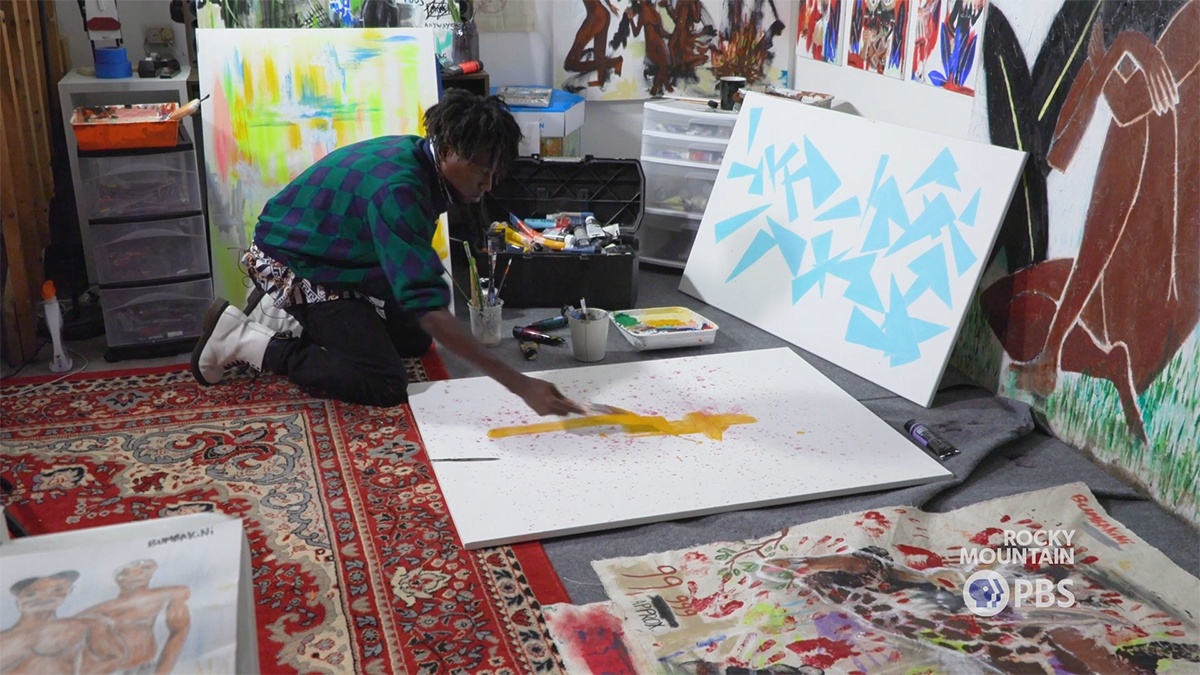Artist Lio-Bravo Bumbakini intersects the American experience with his African heritage

DENVER — When artist Lio-Bravo Bumbakini arrived in Denver, he was a blank canvas.
“I wanted to start over and Denver itself was a blank canvas. The growth of me creatively started as soon as I got here,” the 28-year-old said.
Bumbakini, a self-taught, abstract painter, started pursing art when he moved to Denver from southside Chicago in 2008. While he’s been a full-time artist for the last seven years, Bumbakini told Rocky Mountain PBS that art has been his whole life since the beginning.
“I grew up and was born into a household that was centered around art. My father was in politics, so it was art and politics,” Bumbakini said. “When I was actually in the womb, my mother was setting up her first exhibition in Belgium as a curator. So, I think, really just from l’essence—from the start.”
Originally from Matongé, a Congolese neighborhood in Brussels, Bumbakini has lived in the United States for the majority of his adult life—from Chicago to Denver—with family still residing in the Democratic Republic of Congo.
“I’m really just a citizen of the world,” the artist said.
For Bumbakini, becoming a professional artist was a way for him to find his voice and process everything that was happening to him and around him.
“I'm just a creative vessel,” he said. “For me, I just channel what’s going on in the world. I channel what I dream about; I channel experiences I have in life or experiences others share with me. I try to find spaces within canvases or within other works to illustrate those things I’ve picked up on.”

Spanning paintings, drawings, mixed-media, large-scale murals and digital pieces, Bumbakini’s work provides social commentary on modern, western civilization with contrasting folkloric imagery inspired by his African descent. Though references of his Congolese roots appear throughout his work—like illustrations of rubber trees and wild animals—Bumbakini expressed that they exclusively serve as a basis for his pieces.
“My heritage and background are just who I am. It’s just a foundation for me to be able to look at the world. I can say, ‘yes, I’m from the Congo; yes, I’m from pygmys,’ but today I live in America. I live in the western world,” he said.
While each painting has its own subjective message—Bumbakini said it’s the viewer’s job to figure out what that message is—a considerable amount of his work acknowledges forms of injustice, human suffering, and themes of liberation.
“I started painting the Congo leaf, which is part of the rubber tree,” he said. “Prior to painting it...I never knew about the history of the rubber tree.”
Between 1885 and 1908, King Leopold II used inhumane strategies, known as the Red Rubber System, to collect as much rubber as possible from rubber trees in what is now the Democratic Republic of the Congo.
“King Leopold of Belgium would order quotas for people to cut rubber trees and if people didn’t make their quotas, he would cut their limbs,” Bumbakini recalled. “This is one of the biggest atrocities to ever happen in this world. Over 10 million people died under King Leopold’s ownership of the Congo.”

He added: “These are stories that influences me subconsciously. These are traumas that I did not live, but traumas that I have to relinquish and participate in my artwork.”
Bumbakini considers his craft a conversation he’s having with himself. Throughout his inner dialogue, Bumbakini contemplated what his seeing “when he walks out his front door,” and how he can translate that into “pictorial form.”
“I have to know who I am before I step up to the canvas,” he explained. “This is a conversation I’m having. If I don’t know my opinions or who I am, I can’t have this conversation.”
Right now, one of Bumbakini’s biggest goals is staying alive despite police brutality, crime, and sickness—and making the most of what he has.
“I've never seen anybody like me, make it past a certain age,” he said. “People like to compare me a lot to Basquiat, and I love Basquiat. He’s like a godfather to me, I feel like I have dreams where we have conversations, but Basquiat lived till 27.”
Bumbakini, who just celebrated his 28th birthday, wants to take advantage of his time alive to make a difference and influence as many people as he can while he’s alive.
His other goal, which is arguably less existential, is to increase Black representation and Black narratives in museums—something he noticed while accompanying his mom at work.
“I’ve never seen any art from people like me in a museum. I want to change our narrative so that's why I'm here. And that's my life mission, I'm not going to stop until it happens,” he said. “and if it doesn't happen. I’m going to open a museum of my own.”
This is the third story in a series that will be featured in "Colorado Voices: Artists" airing October 28 at 7 p.m. on Rocky Mountain PBS.
Victoria Carodine is the Digital Content Producer for Rocky Mountain PBS. You can reach her at victoriacarodine@rmpbs.org.
Brian Willie is the Content Production Manager with Rocky Mountain PBS. You can reach him at brianwillie@rmpbs.org.
